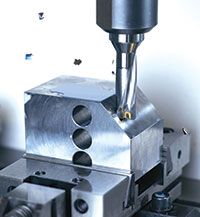by Manfred Lenz
Best practices for choosing the right tools
The world of holemaking subdivides into two separate drill categories: solid carbide and indexable. Both of these types of drills offer strengths and weaknesses that make them ideal for some applications and less suitable for others. Many shops miss critical opportunities to improve their drilling performance because they lack a thorough understanding of when to choose one type of drill over the other. A few straightforward considerations make the difference between an informed selection that elevates the use of drill technologies and a fingers-crossed guess at what works best.
Hole and drill size
Hole size can determine the best type of drill for an individual job. At small sizes, everything about indexable drills shrinks, including their screws and inserts, making them impractical to use. Conversely, at diameters above (12.7 mm) (0.500 in.), indexable drills shine because of their cost effectiveness, with four edges on one insert to keep price per cutting edge low. Overall, even with only one effective flute, indexable drills do require more horsepower, torque and coolant than solid drills, especially above 5.08 mm (2.000 in.) in diameter. By contrast, solid drills become considerably more expensive than indexable drills at large sizes, although using a solid piece of carbide can yield higher proximity and deeper holes than an indexable drill can produce.
 Roughing and finishing
Roughing and finishing
Indexable drills excel in roughing operations, although they also work well for jobs with looser tolerances, such as clearance holes for bolts. In most cases, however, indexable drills require a second pass with a boring head—especially if the drill wanders or deflects—along with a finishing pass with a reamer. Even high precision solid carbide drills may need a secondary operation to obtain a very high quality surface finish because although they hold very tight hole tolerances, they produce a surface finish that typically remains somewhere around a 40 micron Ra. If that finish satisfies the requirements of a job, solid drills can complete operations in a single pass, with no secondary boring or reaming operation required.
Tool performance flexibility
Indexable drills show their versatility when shops need to drill into solid stock; step over and punch holes; and create half holes, holes in corners, inner interruptions and cross holes. The centre insert on indexable drills eliminates the need for a pilot hole, which saves time. Changing inserts and chip breakers transforms one indexable drill into a series of tools, each immediately sharp and ready to target a different material, which helps cut down on tool inventory. Solid drills tolerate a limited number of re-sharpening operations but can’t create more than one type of hole.
 Tool materials
Tool materials
Manufacturers fabricate indexable tool bodies out of tool steel, a metal that can display small amounts of flexing, which can lead to deflection or wandering but avoids the prospect of breakage. Solid carbide’s rigidity increases its accuracy and makes it unlikely to flex, but if carbide does flex, it breaks. Solid carbide drills provide two effective flutes instead of just one and typically run faster than indexable drills do as a result. Additionally, the split point on solid drills centres and locates well, offering good positioning.
Bottom line: Always ask your tool manufacturer for specific input on whether to use an indexable or a solid drill to master a specific project. Field sales reps can offer expert tool recommendations and validate whether a particular product offers the right performance for an individual process. SMT
Manfred Lenz is product manager, holemaking, Seco Tools.
